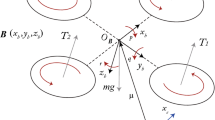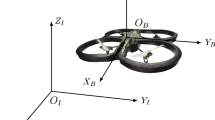Abstract
This paper presents “optimal identification,” a framework for using experimental data to identify the optimality conditions associated with the feedback control law implemented in the measurements. The technique compares closed loop trajectory measurements against a reduced order model of the open loop dynamics, and uses linear matrix inequalities to solve an inverse optimal control problem as a convex optimization that estimates the controller optimality conditions. In this study, the optimal identification technique is applied to two examples, that of a millimeter-scale micro-quadrotor with an engineered controller on board, and the example of a population of freely flying Drosophila hydei maneuvering about forward flight. The micro-quadrotor results show that the performance indices used to design an optimal flight control law for a micro-quadrotor may be recovered from the closed loop simulated flight trajectories, and the Drosophila results indicate that the combined effect of the insect longitudinal flight control sensing and feedback acts principally to regulate pitch rate.















Similar content being viewed by others
References
Aïoun F, Heniche A, Bourlès H (1994) Maximally-diagonal solution to the inverse LQR problem. In: Proceedings of the 33rd conference on decision and control, pp 1445–1446
Beatus T, Guckenheimer JM, Cohen I (2015) Controlling roll perturbations in fruit flies. J R Soc Interface 12(105):20150075
Boyd S, Ghaoui LE, Feron E, Balakrishnan V (1997) Linear matrix inequalities in system and control theory (studies in applied and numerical mathematics). Society for Industrial and Applied Mathematics, Philadelphia
Camhi JM (1970) Yaw-correcting postural changes in locusts. J Exp Biol 52(3):519–531
Cheng B, Fry SN, Huang Q, Deng X (2010) Aerodynamic damping during rapid flight maneuvers in the fruit fly drosophila. J Exp Biol 213:602–612
Conroy J, Gremillion G, Ranganathan B, Humbert JS (2009) Implementation of wide-field integration of optic flow for autonomous quadrotor navigation. J Exp Biol 27:189–198
David CT (1978) The relationship between body angle and flight speed in free-flying drosophila. Physiol Entomol 3(3):191–195
Dickinson MH (1990) Comparison of encoding properties of campaniform sensilla on the fly wing. J Exp Biol 151(1):245–261
Dickinson MH, Lighton JR (1995) Muscle efficiency and elastic storage in the flight motor of drosophila. Science 268(5207):87
Dickinson MH, Muijres FT (2016) The aerodynamics and control of free flight maneuvers in drosophila. Philos Trans R Soc B 371(20150388)
Dickinson MH, Tu MS (1997) The function of dipteran flight muscle. Comp Biochem Physiol A Physiol 116(3):223–238
Dickinson MH, Lehmann FO, Sane SP (1954) Wing rotation and the aerodynamic basis of insect flight. Science 284:1999
Eberle A, Dickerson B, Reinhall PG, Daniel T (2015) A new twist on gyroscopic sensing: body rotations lead to torsion in flapping, flexing insect wings. J R Soc Interface 12(104):20141088
Faruque IA, Humbert JS (2010a) Dipteran insect flight dynamics .Part 2: lateral–directional motion about hover. J Theor Biol 265(3):306–313
Faruque IA, Humbert JS (2010b) Dipteran insect flight dynamics. Part 1: longitudinal motion about hover. J Theor Biol 264(2):538–552
Fiala J, Kocvara M, Stingl M (2013) PENLAB: a MATLAB solver for nonlinear semidefinite optimization. arXiv preprint arXiv:1311.5240
Fry SN, Sayaman R, Dickinson MH (2003) The aerodynamics of free-flight maneuvers in Drosophila. Science 300(5618):495–498
Fujii T, Narazaki M (1984) A complete optimality condition in the inverse problem of optimal control. SIAM J Control Optim 22(2):327–341
Gao N, Aono H, Liu H (2011) Perturbation analysis of 6DoF flight dynamics and passive dynamic stability of hovering fruit fly Drosophila Melanogaster. J Theor Biol 270:98–111
Götz KG (1968) Flight control in drosophila by visual perception of motion. Kybernetik 4(6):199–208
Götz KG (1987) Course-control, metabolism and wing interference during ultralong tethered flight in drosophila melanogaster. J Exp Biol 128(1):35–46
Graetzel CF, Nelson BJ, Fry SN (2010) Frequency response of lift control in Drosophila. J R Soc Interface 7(52):1603–1616
Hedrick TL (2008) Software techniques for two- and three-dimensional kinematic measurements of biological and biomimetic systems. Bioinspir Biomim 3(3):034001
Hedrick TL, Robinson AK (2010) Within-wingbeat damping: dynamics of continuous free-flight yaw turns in Manduca sexta. Biol Lett 6:422–425
Hedrick TL, Cheng B, Deng X (2009) Wingbeat time and the scaling of passive rotational damping in flapping flight. Science 324:252–255
Heisenberg M, Wolf R (2013) Vision in Drosophila: genetics of microbehavior, vol 12. Springer, Berlin
Kalman RE (1964) When is a linear control system optimal. J Basic Eng 86D:51–60
Kennedy J (1983) Zigzagging and casting as a programmed response to wind-borne odour: a review. Physiol Entomol 8(2):109–120
Krapp HG (2009) Ocelli. Curr Biol 19(11):R435–R437
MacFarlane K, Bush B, Faruque I, Humbert JS, Baeder J (2011) Quasi-steady and computational aerodynamics applied to hovering Drosophila dynamics. In: AIAA 29th applied aerodynamics conference, June 2011. Honolulu, Hawaii, No. 2011-3793
MacFarlane KM, Faruque IA, Humbert JS (2015) Power regulation of kinematic control inputs for forward flying Drosophila. Acta Mech Sin 30(6):809–818
Klein V, Morelli E (2002) Aircraft system identification: theory and practice. In: AIAA
Muijres FT, Elzinga MJ, Melis JM, Dickinson MH (2014) Flies evade looming targets by executing rapid visually directed banked turns. Science 344:172
Muijres FT, Elzinga MJ, Iwasaki NA, Dickinson MH (2015) Body saccades of drosophila consist of stereotyped banked turns. J Exp Biol 218(6):864–875
Pringle JWS (1948) The gyroscopic mechanism of the halteres of diptera. Philos Trans R Soc Lond B Biol Sci 233(602):347–384
Ristroph L, Bergou AJ, Ristroph G, Coumes K, Berman GJ, Guckenheimer J, Wang ZJ, Cohen I (2010) Discovering the flight autostabilizer of fruit flies by inducing aerial stumbles. Proc Nat Acad Sci 107(11):4820–4824
Ristroph L, Ristroph G, Morozova S, Bergou AJ, Chang S, Guckenheimer J, Wang ZJ, Cohen I (2013) Active and passive stabilization of body pitch in insect flight. J R Soc Interface 10(85):20130237
Sane SP (2003) The aerodynamics of insect flight. J Exp Biol 206:4191–4208
Sane SP, Dieudonné A, Willis MA, Daniel T (2007) Antennal mechanosensors mediate flight control in moths. Science 315(5813):863–866
Schneider D (1964) Insect antennae. Annu Rev Entomol 9(1):103–122
Sherman A, Dickinson MH (2003) A comparison of visual and haltere-mediated equilibrium reflexes in the fruit fly Drosophila melanogaster. J Exp Biol 206:295–302
Sherman A, Dickinson MH (2004) Summation of visual and mechanosensory feedback in Drosophila flight control. J Exp Biol 207:133–142
Sturm JF (1999) Using SeDuMi 1.02, a MATLAB toolbox for optimization over symmetric cones. Optim Methods Softw 11(1–4):625–653
Straw AD, Lee S, Dickinson MH (2010) Visual control of altitude in flying drosophila. Curr Biol 20(17):1550–1556
Sun M, Wang J, Xiong Y (2007) Dynamic flight stability of hovering insects. Acta Mech Sin 23:231–246
Taylor GK, Thomas ALR (2003) Dynamic flight stability in the desert locust Schistocerca gregaria. J Exp Biol 206:2803–2829
Thompson RA, Wehling MF, Evers J (2008) Evaluation of the haltere as a biologically inspired inertial rate measurement sensor. In: Guidance, navigation, and control conference
van Breugel F, Dickinson MH (2012) The visual control of landing and obstacle avoidance in the fruit fly drosophila melanogaster. J Exp Biol 215(11):1783–1798
van Breugel F, Dickinson MH (2014) Plume-tracking behavior of flying drosophila emerges from a set of distinct sensory-motor reflexes. Curr Biol 24(3):274–286
Vela PA, Burdick JW (2003) Control of biomimetic locomotion via averaging theory. In: Proceedings of the IEEE international conference on robotics and automation, 2003, ICRA’03, vol 1, pp 1482–1489
Wehner R (1981) Spatial vision in arthropods. In: Autrum H (ed) Handbook of sensory physiology, vol 7/6C. Springer, Berlin, pp 287–616
Weis-Fogh T (1949) An aerodynamic sense organ stimulating and regulating flight in locusts. Nature 164(4177):873. https://doi.org/10.1038/164873a0
Wu JH, Mao S (2012) Floquet stability analysis of the longitudinal dynamics of two hovering model insects. J R Soc Interface 9(74):2033–2046
Ye Y, Todd MJ, Mizuno S (1994) An O (nL)-iteration homogeneous and self-dual linear programming algorithm. Math Oper Res 19(1):53–67
Author information
Authors and Affiliations
Corresponding author
Additional information
This work sponsored in part by the US Air Force Office of Scientific Research (FA95501410068) and by the US Army Research Laboratory (W911NF-08-2-0004). Special thanks to Prof. Michael Dickinson’s laboratory at Caltech for providing the Drosophila data for analysis.
Rights and permissions
About this article
Cite this article
Faruque, I.A., Muijres, F.T., Macfarlane, K.M. et al. Identification of optimal feedback control rules from micro-quadrotor and insect flight trajectories. Biol Cybern 112, 165–179 (2018). https://doi.org/10.1007/s00422-017-0742-x
Received:
Accepted:
Published:
Issue Date:
DOI: https://doi.org/10.1007/s00422-017-0742-x




